20 Birds With Orange Bellies (with Pictures)
Last Updated on
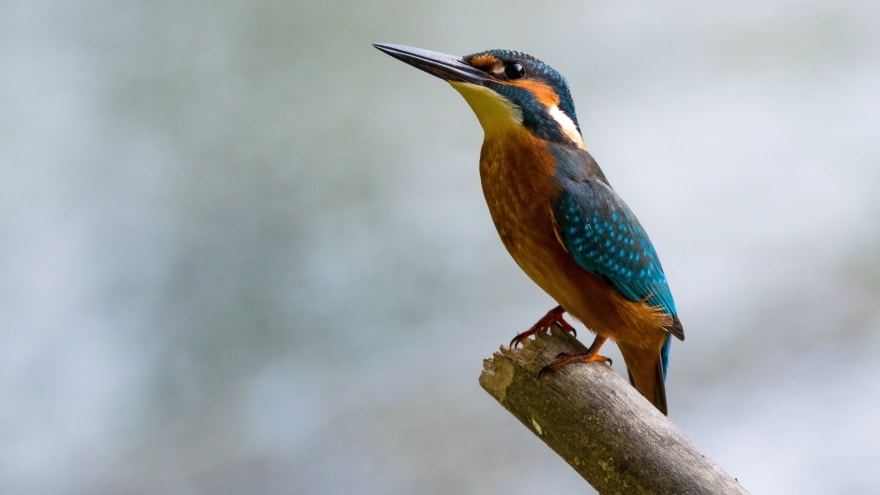
We all know that it’s fun to watch birds. One of the things that make it so enjoyable is seeing birds with bright colors, such as birds with orange bellies.
So, whether you’re looking to spot a bird with an orange belly and want to know what’s out there or you are trying to identify a bird that you’ve already spotted, you’ve come to the right place!

The 20 Birds with Orange Bellies
1. Baltimore Oriole

| Scientific Name | Icterus galbula |
| Length | 6 to 8 inches |
| Weight | 1 to 1.5 ounces |
| Wingspan | 9 to 12 inches |
| Population | 6 million |
| Region | Central and eastern United States, Central America, and northern South America |
If you’re looking for a famously orange bird, it’s hard to top the Baltimore Oriole. They’re a black bird, but the chest and belly area are bright orange.
Despite the name “Baltimore,” they have a wide range around the eastern half of the United States, and they’ll venture all the way down to parts of South America.
Their population numbers are dwindling, though, so it might be a bit more challenging to spot a Baltimore Oriole in the years to come.
2. Allen’s Hummingbird
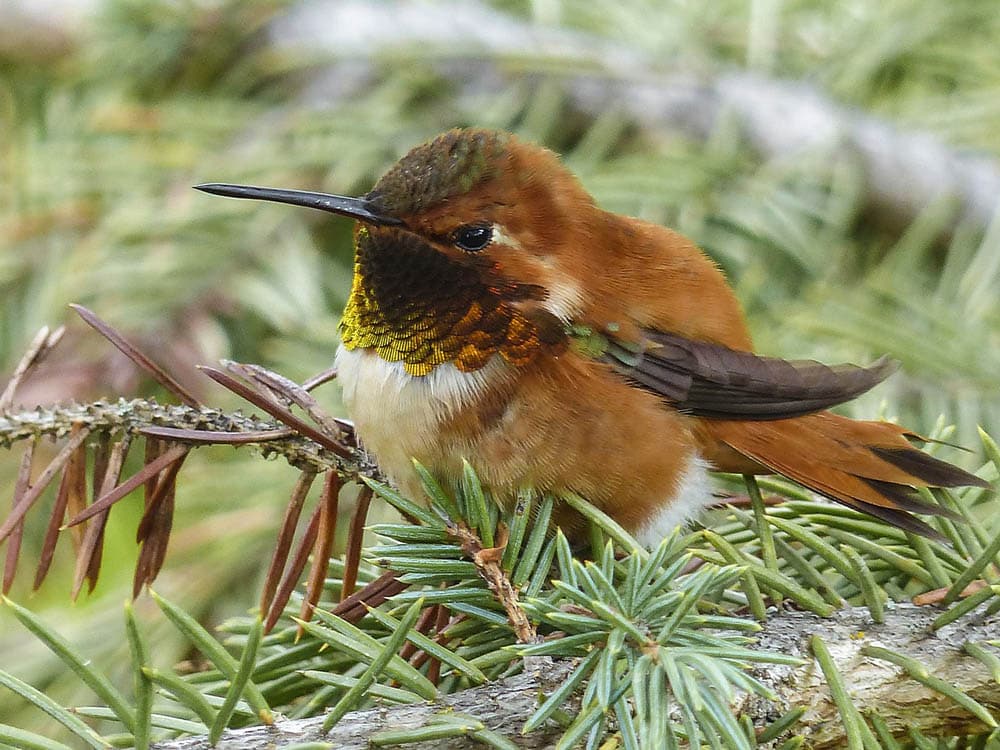
| Scientific Name | Selasphorus sasin |
| Length | 3 to 3.5 inches |
| Weight | 0.1 to 0.2 ounces |
| Wingspan | 4.5 to 5 inches |
| Population | 1.7 million |
| Region | Coastal west coast regions and central Mexico |
Who doesn’t love a hummingbird? If you live on the west coast and spot a hummingbird with an orange chest, there’s a good chance that you’re looking at a male Allen’s Hummingbird.
Females might have a faint copper hue, but it’s nowhere near as distinct as it is on the males.
3. Northern Red Bishop

| Scientific Name | Euplectes franciscanus |
| Length | 4 to 4.5 inches |
| Weight | 0.4 to 0.75 ounces |
| Wingspan | 7.5 to 8.5 inches |
| Population | Unknown |
| Region | Africa, southern California, and the Houston area |
It might be the “Red” Bishop, but you’ll see a clear orange color when you look at them. They’re native to regions in Africa, but they have established small nesting grounds in southern California and the Houston, Texas, area.
These populations come from pets released into the wild, though, so their numbers are extremely small.
4. House Finch
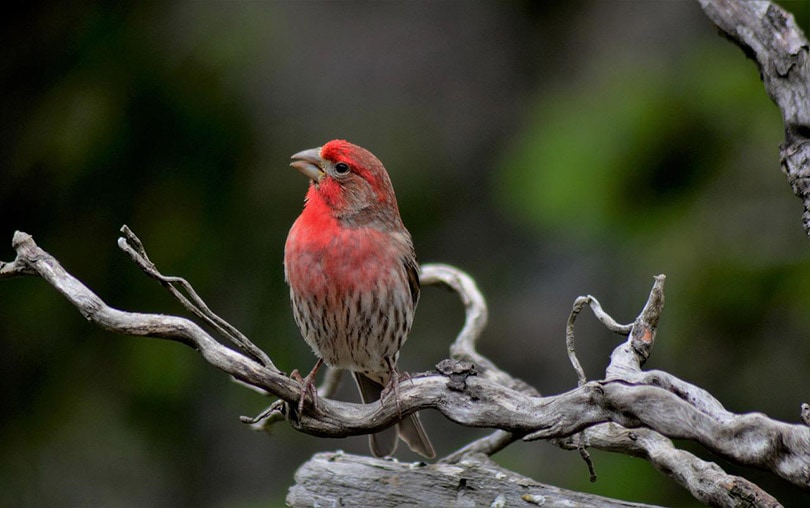
| Scientific Name | Haemorhous mexicanus |
| Length | 5 to 6 inches |
| Weight | 0.65 to 0.8 ounces |
| Wingspan | 8 to 10 inches |
| Population | 40 million |
| Region | Western North America, the eastern United States, and Hawaii |
House Finches come in tons of different colors and appearances, so it’s not a huge surprise that there are House Finches with orange chests.
If you live in the United States, these small birds are plentiful and are common in backyards and suburbs.
5. American Robin
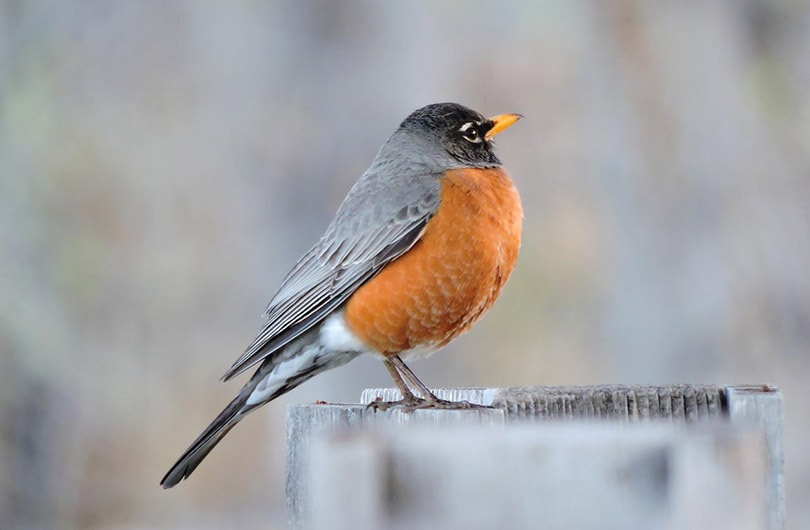
| Scientific Name | Turdus migratorius |
| Length | 9.1 to 11 inches |
| Weight | 2.5 to 3 ounces |
| Wingspan | 12 to 16 inches |
| Population | 370 million |
| Region | North America |
If you spotted a bird with a distinct orange chest in your backyard, you probably saw an American Robin. Not only do they have a bright orange chest that makes them stand out, but there are tons of American Robins out there.
They’re larger than many other birds too, making them stand out in yards and parks.
6. Barn Swallow

| Scientific Name | Hirundo rustica |
| Length | 5.7 to 7.8 inches |
| Weight | 0.6 to 0.7 ounces |
| Wingspan | 12.5 to 13.5 inches |
| Population | 190 million |
| Region | North and Central America |
Barn Swallows may not come right to mind when you think of birds with orange chests, but they do have a cinnamon-colored chest that they can puff out.
It is important to note that not every Barn Swallow has an orange chest; sometimes, it’s a bright white instead.
7. Bullock’s Oriole

| Scientific Name | Icterus bullockii |
| Length | 6.6 to 7.6 inches |
| Weight | 1 to 1.5 ounces |
| Wingspan | 11.5 to 12.5 inches |
| Population | 7 million |
| Region | Western North America and Central America |
Unlike the Baltimore Oriole, the Bullock’s Oriole has a yellow/orange appearance instead of a distinct bright orange.
While you find Baltimore Orioles on the eastern side of the Americas, you’ll have to head out to the west coast to find a Bullock’s Oriole.
9. Western Bluebird

| Scientific Name | Sialia Mexicana |
| Length | 6.5 to 7.5 inches |
| Weight | 0.8 to 1.1 ounces |
| Wingspan | 11.4 to 13.4 inches |
| Population | 6.7 million |
| Region | Central and western North America |
While the Western Bluebird is certainly bluer than anything else, when you look at their chest, orange is there.
It contrasts beautifully with the blue and makes for an amazing-looking bird that you can find in the western states of North America.
9. American Woodcock

| Scientific Name | Scolopax minor |
| Length | 10 to 12 inches |
| Weight | 6.8 to 7 ounces |
| Wingspan | 19 to 21 inches |
| Population | 5 million |
| Region | Eastern and central United States |
If you look at a picture of the American Woodcock, the orange chest might not stand out to you. It’s more of a brownish color, but it does have an unmistakable orange hue.
10. Blackburnian Warbler

| Scientific Name | Setophaga fusca |
| Length | 4.3 to 4.7 inches |
| Weight | 0.3 to 0.4 ounces |
| Wingspan | 7.9 to 9.1 inches |
| Population | 14 million |
| Region | North America |
The Blackburnian Warbler is an example of a bird that has a yellow/orange chest. Many of these birds have a bright orange hue around the chest, and it blends to a more yellow color for the underbody and around the wings.
11. Eastern Bluebird

| Scientific Name | Sialia sialis |
| Length | 6.3 to 8.3 inches |
| Weight | 1 to 1.1 ounces |
| Wingspan | 9.8 to 12.6 inches |
| Population | 23 million |
| Region | Eastern and midwestern United States |
The Eastern Bluebird is a close relative to the Western Bluebird, so it’s no surprise to see them both on this list. However, the Eastern Bluebird’s orange chest has more of a copper tint, so it doesn’t stand out quite as much as that of the Western Bluebird.
12. Rufous Hummingbird
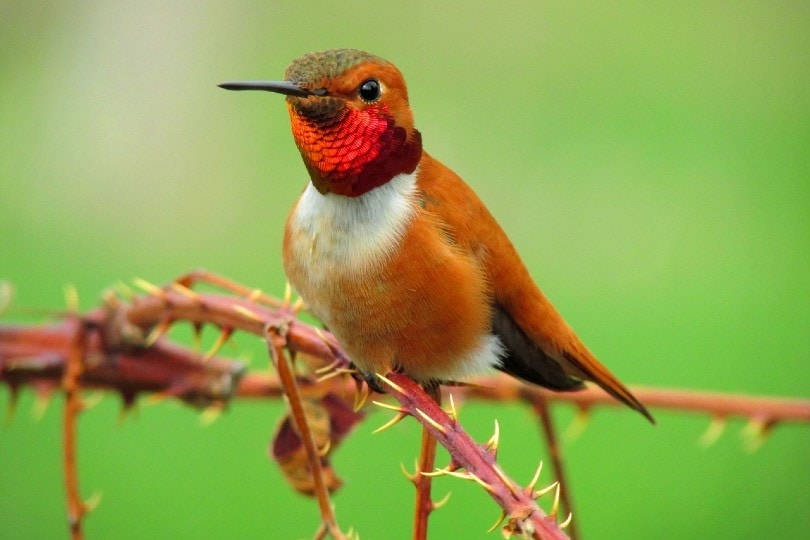
| Scientific Name | Selasphorus rufus |
| Length | 2.8 to 3.5 inches |
| Weight | 0.1 to 0.2 ounces |
| Wingspan | 4 to 4.5 inches |
| Population | 22 million |
| Region | Western North America |
The Rufous Hummingbird has a distinct orange coloring. You can find them along the Pacific coast of North America, all the way from Alaska to Mexico.
You’ll also see these beautiful birds up in the Rocky Mountains in the summer and fall. If you fall along their migratory route, you’ll see plenty of these orange birds flying through.
13. Varied Thrush

| Scientific Name | Lxoreus naevius |
| Length | 7.5 to 10.2 inches |
| Weight | 2.3 to 3.5 ounces |
| Wingspan | 13.4 to 15 inches |
| Population | 20 million |
| Region | Western United States |
The Varied Thrush has two distinct hues throughout their body: a gray/black mixed with an orange/yellow. The chest is a distinctive orange color, with a black band going across it, and you can see flakes of the same yellow/orange hue throughout the rest of the body.
It’s a bird that you can spot in the western United States, as they enjoy the more temperate climate there.
14. Scarlet Tanager
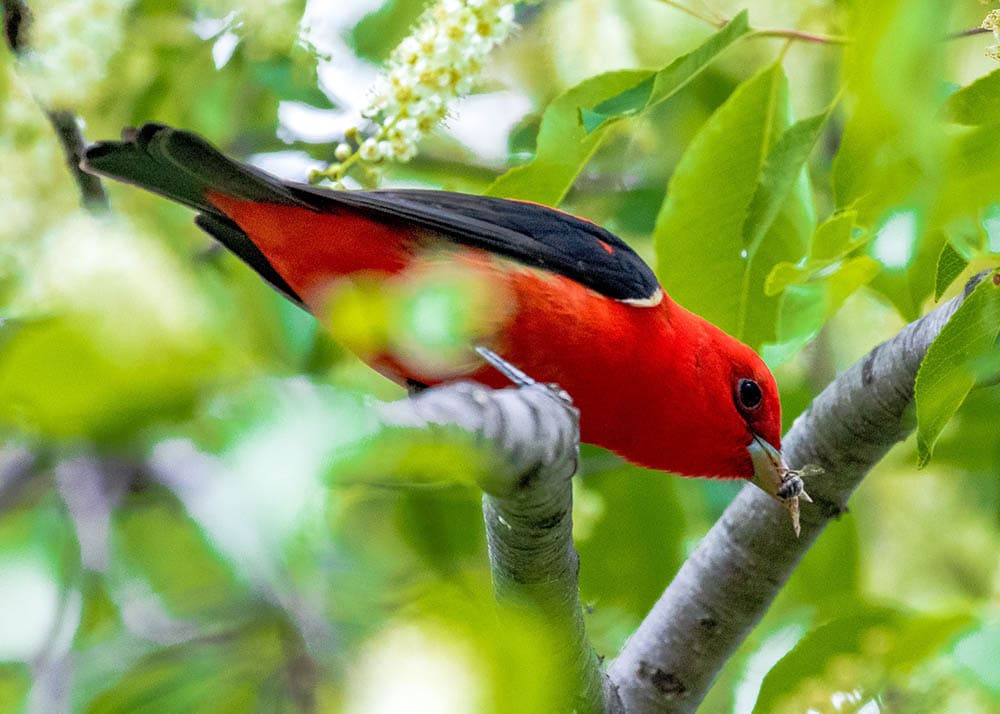
| Scientific Name | Piranga olivacea |
| Length | 6.3 to 6.7 inches |
| Weight | 0.8 to 1.3 ounces |
| Wingspan | 9.8 to 11.4 inches |
| Population | 2.6 million |
| Region | Eastern United States, Central America, and western/northern South America |
The Scarlet Tanager is a small, puffy-looking bird that you can find throughout the eastern portion of the United States and down through Central and South America, depending on the season.
They’re incredibly bright, and despite their name, quite a few of these birds have a distinct orange hue instead of the signature red.
15. Say’s Phoebe

| Scientific Name | Sayornis saya |
| Length | 6.5 to 6.9 inches |
| Weight | 0.7 to 0.8 ounces |
| Wingspan | 12 to 14 inches |
| Population | 4 million |
| Region | Western and central United States and Mexico |
While many of the birds on this list have a bold and bright appearance, Say’s Phoebe doesn’t meet that criterion. They’re a mostly brown-and-gray bird, with a copper color throughout the chest and underbody that has an orange hue in the right light.
16. Red Knot

| Scientific Name | Calidris canutus |
| Length | 9.1 to 10.6 inches |
| Weight | 4.4 to 7.2 ounces |
| Wingspan | 22.4 to 23.6 inches |
| Population | 1 million |
| Region | Canadian arctic, Florida, Gulf Coast, Caribbean, northern Brazil, the coast of Chile and Argentina |
The Red Knot is a shorebird that looks like a cross between a Seagull and a Duck, which makes sense considering the extreme temperature swings that it can handle. You can find it along the shore of the Florida Gulf Coast region and all the way down to northern Brazil.
However, they spend most of their time up in the Canadian arctic, which is why they need a duck-like coating for the extra insulation!
- See also: 15 Birds with Long Legs
17. Red-Breasted Nuthatch
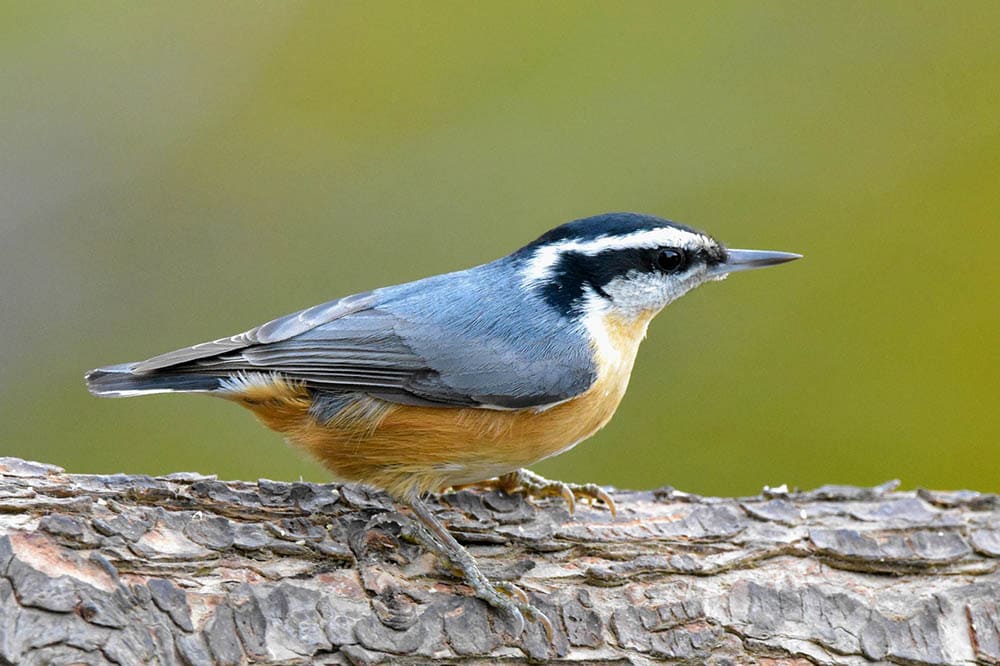
| Scientific Name | Sitta canadensis |
| Length | 4.3 to 4.5 inches |
| Weight | 0.3 to 0.5 ounces |
| Wingspan | 7.1 to 7.9 inches |
| Population | 18 million |
| Region | North America |
The name of this bird is a bit of a misnomer. The chest has a more orange/brown appearance, and not much red shines through. You can find the tiny Red-Breasted Nuthatch throughout most of North America, but you’ll have to keep a sharp eye out for them due to their small size.
18. Orange-Breasted Falcon

| Scientific Name | Falco deiroleucus |
| Length | 13 to 16 inches |
| Weight | 1 to 1.5 pounds |
| Wingspan | 32 to 35 inches |
| Population | Unknown, likely fewer than 1,000 |
| Region | Sporadic regions between Mexico and Argentina |
The Orange-Breasted Falcon is much larger than any other bird on this list. In fact, it can weigh a full 1 ½ pounds!
However, if you’re looking to spot a wild Orange-Breasted Falcon, good luck. There’s not an exact number available for the number of these birds left, but most estimates have it well under 1,000.
19. Orange-Breasted Sunbird
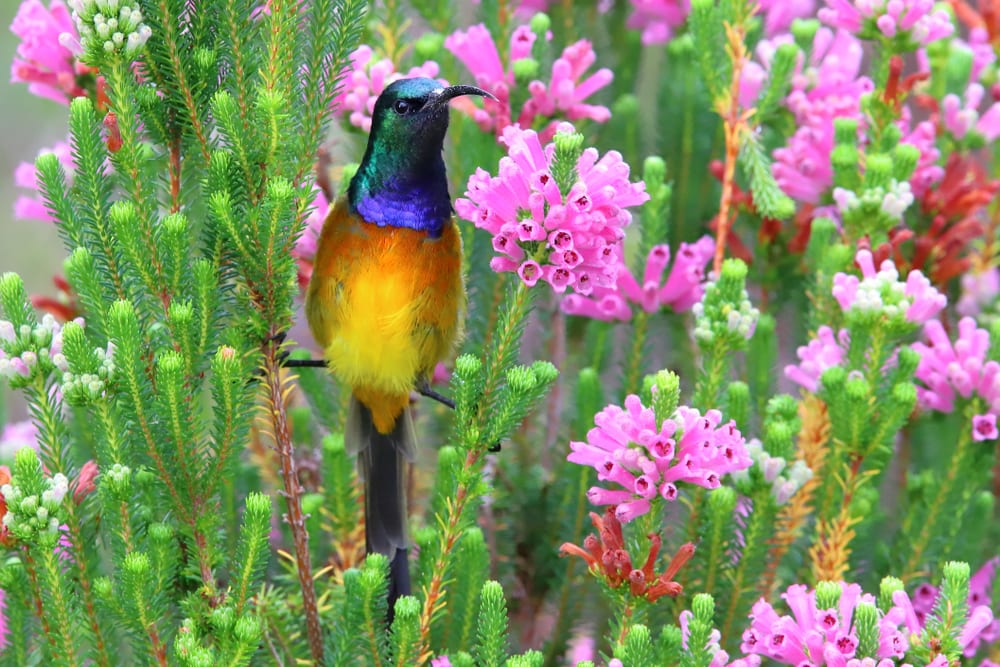
| Scientific Name | Anthobaphes violacea |
| Length | 5 to 6.5 inches |
| Weight | 0.3 to 0.35 ounces |
| Wingspan | 4.9 to 6.5 inches |
| Population | Unknown |
| Region | Southwestern South Africa |
If you spot a male Orange-Breasted Sunbird, it’s not likely a bird that you’ll forget. This bird has tons of bright colors. Orange, tallow, turquoise, and purple are the most obvious, but only in males.
You’ll also need to travel to southwestern South Africa to spot these birds, as they only live in this region of the world!
20. Common Kingfisher
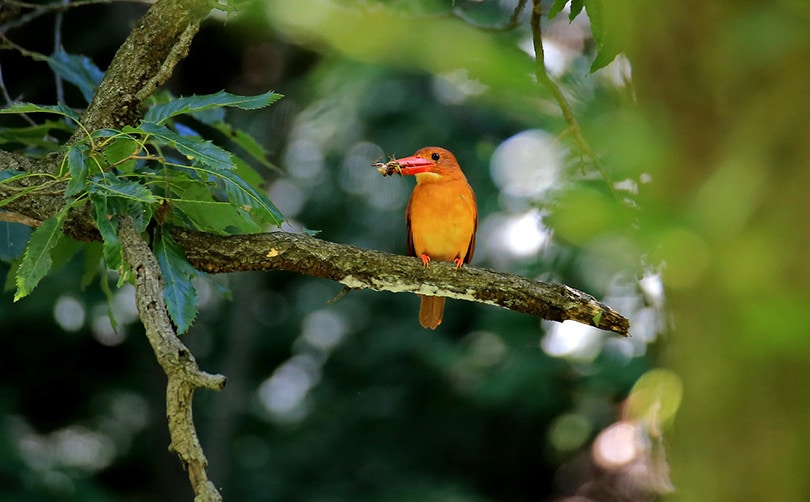
| Scientific Name | Alcedo atthis |
| Length | 6.3 to 6.7 inches |
| Weight | 1.25 to 1.4 ounces |
| Wingspan | 9.5 to 10 inches |
| Population | 160,000 to 320,000 |
| Region | Europe, Asia, and North Africa |
The common kingfisher is anything but “common.” The population numbers for these birds are dwindling, but they are among the most impressive-looking birds out there. They have a bright blue head and upper body, which is in stark contrast to their brown/copper lower body.
You can find them throughout Europe, Asia, and North Africa, but keep in mind that since there aren’t many of these birds left, their large range makes them a bit tricky to spot.
Conclusion
Orange birds have a certain appeal that makes them exciting to track down and watch. Now that you have a better understanding of what’s out there, you can identify the next bird that you see with an orange chest or know where to head out to spot one for the first time!
Featured Image Credit: Piqsels
Table of Contents
- The 20 Birds with Orange Bellies
- 1. Baltimore Oriole
- 2. Allen’s Hummingbird
- 3. Northern Red Bishop
- 4. House Finch
- 5. American Robin
- 6. Barn Swallow
- 7. Bullock’s Oriole
- 9. Western Bluebird
- 9. American Woodcock
- 10. Blackburnian Warbler
- 11. Eastern Bluebird
- 12. Rufous Hummingbird
- 13. Varied Thrush
- 14. Scarlet Tanager
- 15. Say’s Phoebe
- 16. Red Knot
- 17. Red-Breasted Nuthatch
- 18. Orange-Breasted Falcon
- 19. Orange-Breasted Sunbird
- 20. Common Kingfisher
- Conclusion
About the Author Robert Sparks
Robert’s obsession with all things optical started early in life, when his optician father would bring home prototypes for Robert to play with. Nowadays, Robert is dedicated to helping others find the right optics for their needs. His hobbies include astronomy, astrophysics, and model building. Originally from Newark, NJ, he resides in Santa Fe, New Mexico, where the nighttime skies are filled with glittering stars.
Related Articles:
Monocular vs Telescope: Differences Explained (With Pictures)
10 Types of Hummingbirds in Arkansas (With Pictures)
8 Types of Hummingbirds in Nebraska (With Pictures)
5 Types of Hummingbirds in Idaho (With Pictures)
3 Types of Hummingbirds in Mississippi (With Pictures)
8 Types of Hummingbirds in Kansas (With Pictures)
5 Types of Hummingbirds in West Virginia (With Pictures)
5 Types of Hummingbirds in Ohio (With Pictures)
